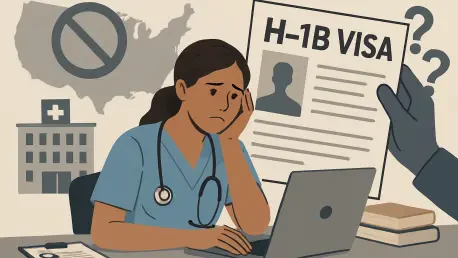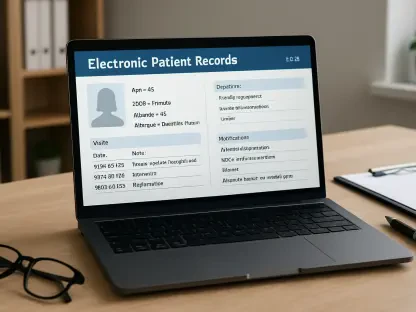I’m thrilled to sit down with James Maitland, a renowned expert in healthcare policy and immigration law, whose deep understanding of visa programs like the H-1B has made him a trusted voice on workforce challenges in the U.S. healthcare system. With a career dedicated to analyzing how policy shifts impact hospitals, clinics, and patient care, James offers invaluable insights into the recent changes to the H-1B visa program under the Trump administration. In this conversation, we explore how these reforms could exacerbate labor shortages, particularly in underserved areas, the financial strain on healthcare providers, and the broader implications for the industry’s ability to serve communities in need.
Can you walk us through what the H-1B visa program is and why it plays such a critical role in the healthcare sector?
Absolutely. The H-1B visa program allows U.S. employers to hire foreign workers for specialty occupations, and in healthcare, it’s a lifeline for filling roles that domestic talent alone can’t cover. We’re talking about positions like physicians, nurses, and health IT specialists. Hospitals and clinics, especially in rural or underserved regions, rely on this program to bring in skilled professionals who keep their doors open. Without it, many communities would face even graver shortages, directly affecting patient access to care.
What specific changes has the Trump administration introduced to the H-1B program, and how are they shaking things up?
There are two major changes causing a stir. First, there’s a massive hike in application fees—jumping from a range of $2,000 to $5,000 to as much as $100,000 per applicant. Second, they’ve revamped the lottery system used when applications exceed the annual cap of 85,000 visas. Instead of a random selection, the new process prioritizes higher-paid, more experienced workers. This shift could sideline early-career doctors or international medical graduates who are crucial to many healthcare settings but don’t yet command top salaries.
How do you see these changes impacting healthcare providers, especially in rural or underserved communities?
These areas are going to feel the brunt of this. Rural hospitals already struggle to attract domestic talent due to lower pay and remote locations, so they depend heavily on international medical graduates. These workers often make up a significant portion of the physician workforce in such regions—sometimes over half. If providers can’t afford the new fees or if the lottery system pushes these applicants out, we could see clinics closing or reducing services, leaving patients with nowhere to turn for care.
What has been the response from major healthcare organizations to these visa reforms?
Groups like the American Hospital Association and the American Medical Association are sounding the alarm. They’ve called these changes a direct threat to the healthcare talent pipeline, especially in areas already grappling with shortages. They’re pushing for exemptions or alternative pathways to keep international workers in the system and are actively lobbying the government to highlight how vital these professionals are to public health. It’s a unified front to protect access to care.
Let’s dive into the financial side—how are these fee increases affecting healthcare providers’ budgets?
The fee hike is a gut punch for many providers, especially nonprofits and smaller facilities. Most hospitals don’t have an extra $100,000 per applicant just sitting around. They’re already stretched thin with rising operational costs and tight margins. To cover these fees, they might have to cut staff, reduce services, or delay investments in equipment or infrastructure. It’s a brutal trade-off that could compromise the quality of care they’re able to provide.
There’s talk of exemptions for roles deemed in the ‘national interest.’ How might this apply to healthcare workers, and do you think it’s a viable solution?
The idea of ‘national interest’ exemptions could offer some relief, particularly for doctors and other critical healthcare roles. The government might prioritize positions that address urgent public needs, like physicians in shortage areas. But the catch is in the details—how will they define and apply these exemptions? I’m skeptical that it will fully address the scale of the problem. The process could be slow or inconsistent, leaving many providers in limbo while they wait for clarity.
Looking at the bigger picture, how do these visa changes tie into the ongoing healthcare workforce shortages across the country?
These changes couldn’t come at a worse time. The U.S. healthcare system is already battling severe shortages due to an aging population, burnout among workers, and a lack of educators to train new professionals. H-1B workers have been a crucial stopgap, especially for roles like nursing where there’s no surplus of domestic talent waiting to step in. Restricting this program risks deepening the crisis, potentially leading to longer wait times for patients and overburdened staff. It’s a step backward when we need all hands on deck.
What’s your forecast for the future of the H-1B program and its role in addressing healthcare shortages?
I think we’re in for a rocky period. The current administration’s focus on restricting immigration could keep these policies tight, but there’s also pushback from healthcare groups and potential litigation that might force some rollbacks or carve-outs. Bipartisan support in Congress for leveraging unused visas to bring in more doctors and nurses is a glimmer of hope. Long-term, though, we need a broader overhaul of immigration policy to align with workforce needs. Without that, healthcare shortages will persist, and patient care will suffer. I’m cautiously optimistic that advocacy and legal challenges will keep the conversation alive, but it’s going to be a fight.









